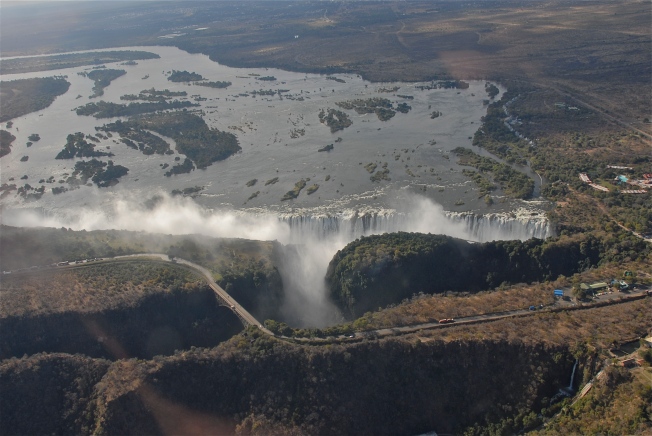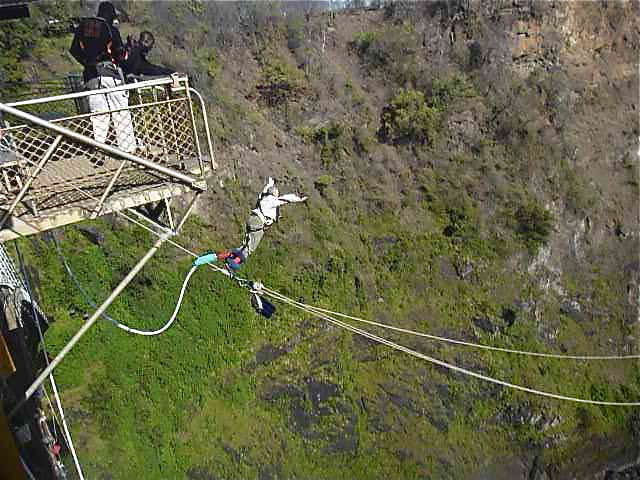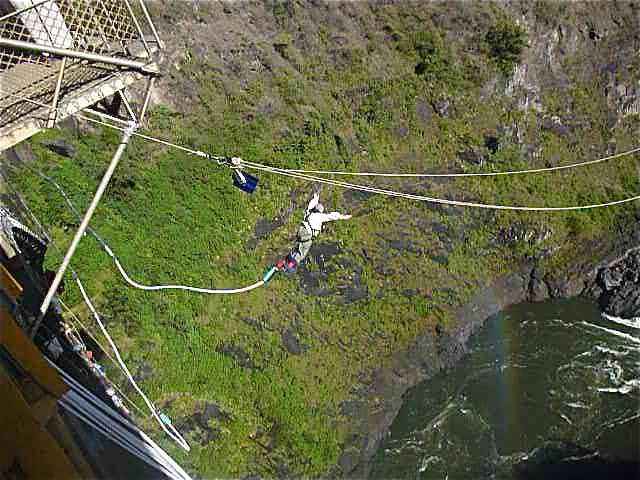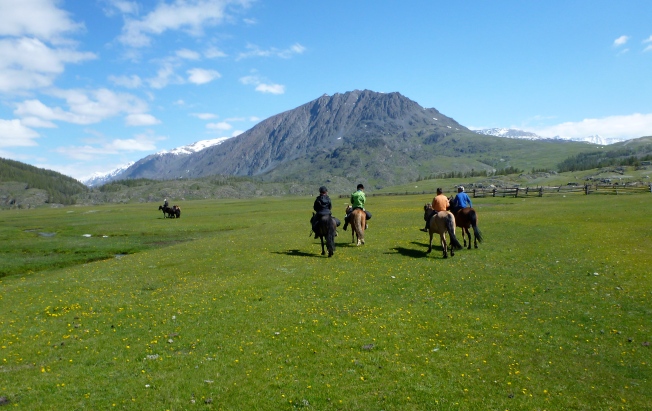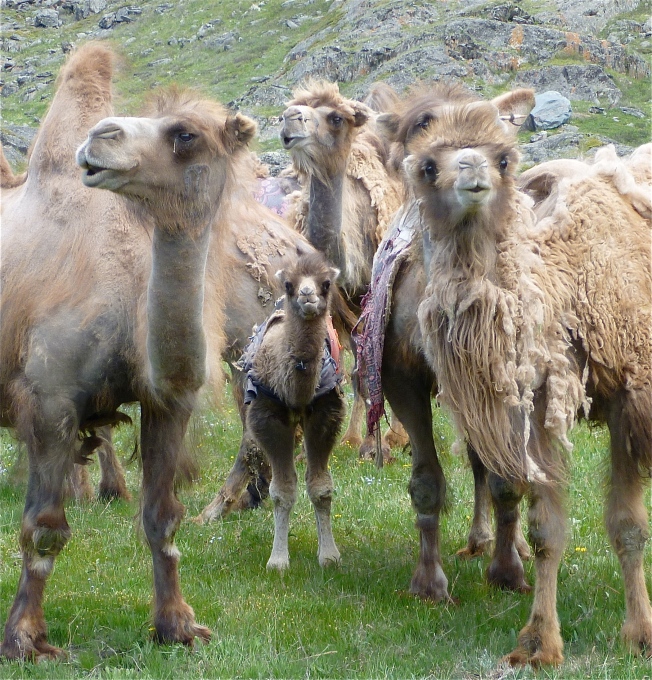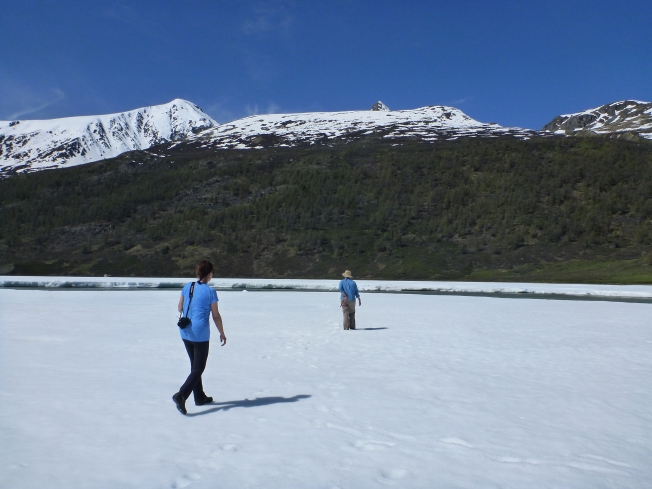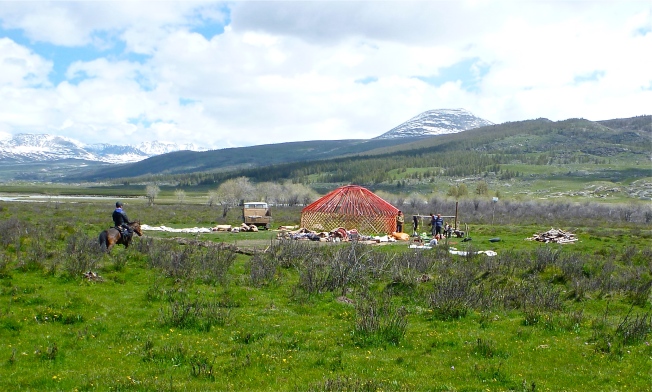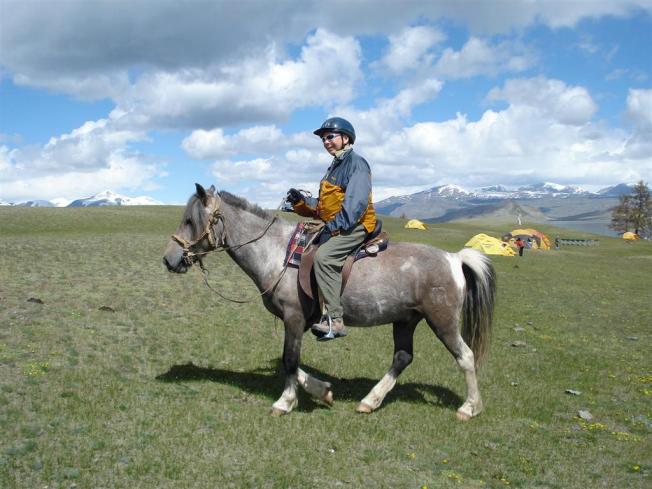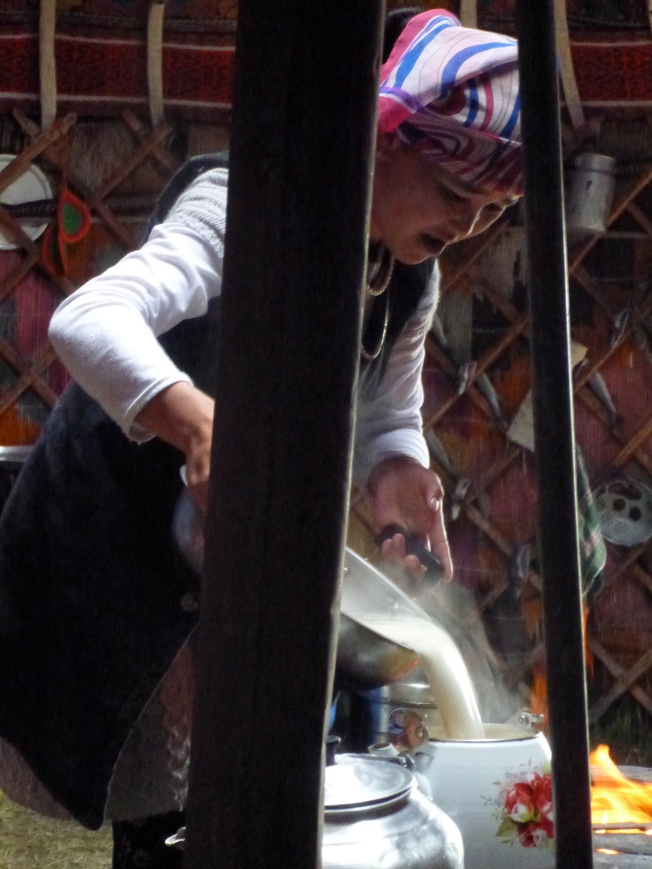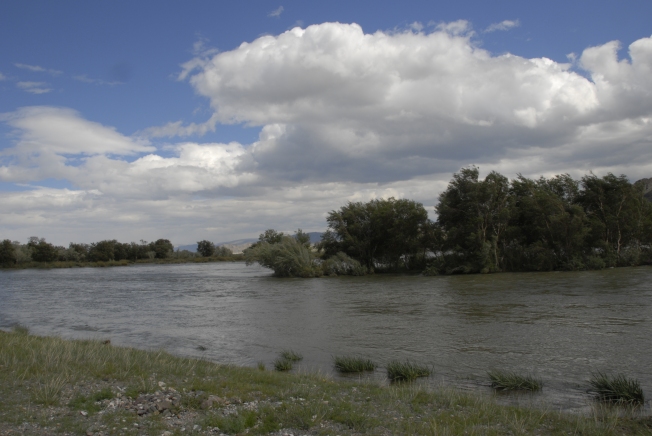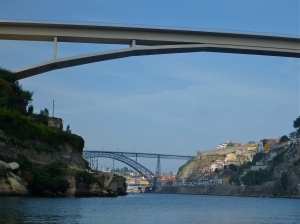
Shane
When I think back on our trip down the Fraser, one image stands out: Shane. With his long white hair and piercing gaze, he looks like a larger-than-life, stereotypical river guide. After we set off in the powered rafts the first morning, he talked non-stop for 30 minutes, and I wondered if he was going to talk all the way to Yale. Later, when I mentioned this to Sue, owner of Fraser River Raft Expeditions, she laughed and said, “And he did, didn’t he?” Yes, Shane talked a lot, because he has an encyclopedic knowledge of the river and its history. It’s worth taking the trip just to learn from him, especially about the mining operations that seemingly transformed almost the entire river valley.
Our new rafts were loaded with an unbelievable amount of gear (loading them each morning was like trying to assemble a thousand-piece jigsaw puzzle), but they still provided plenty of room to spread out in comfort and enjoy the view.
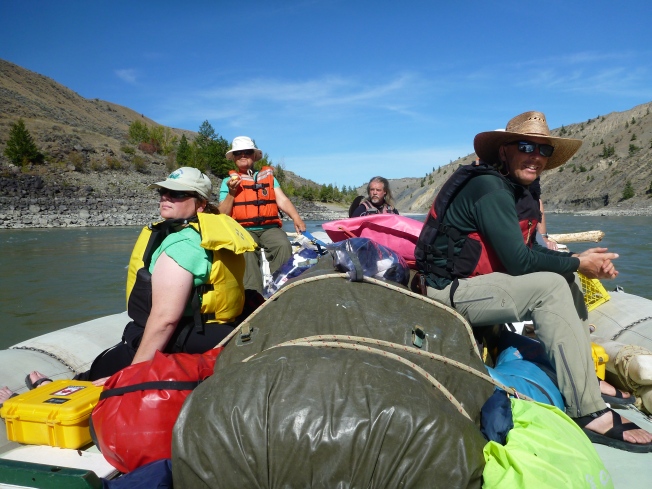
At ease in the sun. Shane at the helm.
Most of the time, we floated with the current, reserving the surprisingly quiet motor for rapids or when we needed to make up time. Some of the guides who were with us on the first part of the trip continued with us for a while, enjoying a break from rowing. Lisa was the working guide on the second raft; she’s at left below, eating an apple.

All play and no work? Lazy day on the river, or a river guide’s dream job.
The big rafts easily rode waves that would have tossed our smaller crafts about. Not that we didn’t get wet; the Fraser has big, big rapids in keeping with its size, and we soon got to experience them. Unfortunately for my blog, big, big rapids require hanging on to the raft with both hands, and since I couldn’t work my little Lumix with my teeth, I didn’t get any photos of them. There probably is a GoPro in my future.

Sailing through troubled waters. NH
The Fraser does not disappoint in scenery, which is as majestic and beautiful as the river.

Wondrous rock formations. White lines show earlier water levels. Water was low when we went through.

Terraces, showing earlier river beds.

Sand, sage brush, rock and a bit of greenery.

Shane shows us some petroglyphs. NH

Dwarfed.

Just resting my eyes. Well, this is supposed to be a holiday, isn’t it? NH
We always went ashore for lunch, and the Fraser offered no shortage of scenic, sandy beaches.

Coming ashore. NH
Sue, Shane, and Lisa, as well as the guides who were on holiday, all saw to our comforts, even at the lunch stops. On some days, the sun was so hot that protective tarps and umbrellas had to be set up. From the lunch spot below, we could see hoodoos and the strangely flat ridge tops that revealed former river beds. Coming from the Rocky Mountains, I am more used to rounded hilltops like those in the background. Our rivers cut through rock and leave a different footprint on the landscape.

Lunch on a sandy beach. NH
The haunting beauty of sand, water and rock remains one of my most precious memories of the trip.

Beautiful shoreline.
Most of our campsites were on sand, which was wonderfully comfortable when dry, miserable after it rained.

Torch light at supper? I never expected that. NH
On a clear night, the sky provided all the entertainment we could ask for.

Starlight and campfire. NH
We didn’t have time for a lot of hiking on this trip, but on one layover day, several people walked up to a place called the Cathedral, an impressive rock formation that also provided a fine view.

The Cathedral. NH

A fine view. NH
Have I mentioned the food? Locally supplied fruit and vegetables were better than anything one can buy in a supermarket. And Sue and Lisa should open a restaurant.

Sue (right) and Lisa and some of their handiwork.

Breakfast. Or why you should not expect to lose weight on this trip.
Most of the wildlife we saw was of the avian variety, but the occasional black bear put in an appearance and we also saw some sheep.

Sheep. NH
Ferries, abandoned mining buildings, roads and railroads tell a story of human imprint on the land, an imprint that is missing from the northern rivers I have travelled. I find no beauty in them, but Shane made them fascinating.

Remnants of gold mining. The rocks on the bottom were purposely washed down the canyon in the search for gold.
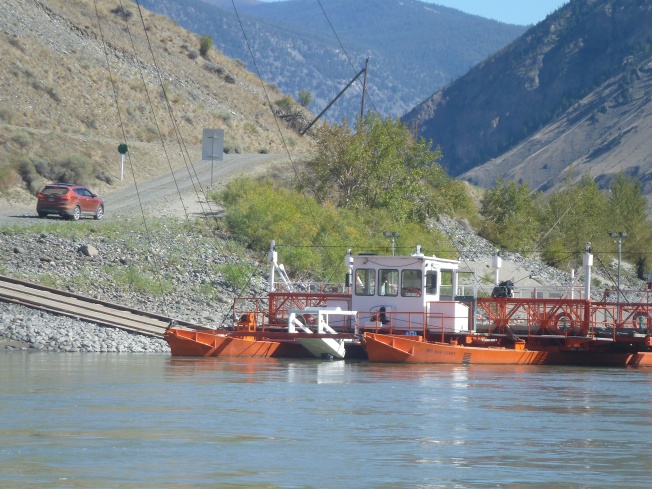
Ferry. The lands on both sides of the river are sparsely populated, so a ferry makes more sense than a bridge.
In places, the roads had to be buttressed by retaining walls of stone. I can only marvel at the intense labour involved.

Support structure.
The river became ever more impressive and the rapids fiercer. At one point, we had to walk while the guides took the rafts through a dangerous passage.

With waves towering over his head, Shane holds to his course.
The final days were quite different. We enjoyed a community dinner put on by the First Nations people of one town, took a group of elders down the river, slept in teepees our final night, joined a very scholarly group on the last day, and (at last!) rafted through Hell’s Gate.

The vacationing guides had left us, and a group of elders filled the second raft.

Teepee lodging. Slept on the grass. By now, I was tired of my tent.

Last day on the river. Joined by a group taking a very educational tour. When there’s no baggage, the rafts hold quite a few people.
Hell’s Gate wasn’t the most exciting rapid we experienced, as it lasted only a few seconds, but it was certainly the most famous. With a bridge, cable car and restaurant above the rapid, we were sure to have an audience, and we circled around in quiet water for a few minutes, hoping that someone would notice. A few people came onto the bridge, probably thinking that we were crazy.

Shane preparing to run a rapid.

Without a GoPro or similar camera, this is about all you can photograph at Hell’s Gate. You can see the bridge and the cable car, and the narrow passage that gives the rapid its name.
To quote from the FRRE brochure, “The grand finale is the roller-coaster action of Sailors Bar rapids, a chain of huge standing waves that we rerun several times.” I think it was in these rapids that I almost went flying out of the raft. We ran them three times, and I doubt that I could have held on for a fourth. But they were indeed, a grand finale.
My heartfelt thanks to Neil, Tyler and Sue for making this trip possible. For someone who is addicted to Canada’s north, it was an eye-opening experience and one of the best trips I taken in the course of a long life.
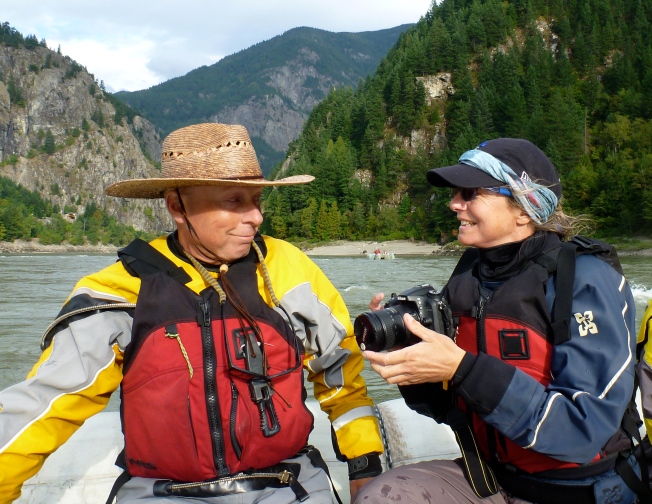
End of the line. Do Neil and Ester look happy?
































